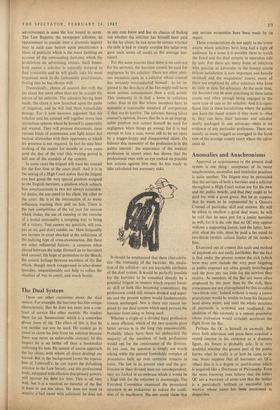The Dual System
There are other curiosities about the dual system. For example, the barrister has this unique characteristic, that he does not enter into a con- tract of service like other mortals. He renders them for an 'honorarium' which is a somewhat glossy form of tip. The effect of this is that he can neither sue nor be sued. He cannot go to court to claim his fees from his solicitor because there was never an enforceable contract. In this respect he is no better off than a bookmaker collecting his bets. He cannot of course approach the lay client, with whom all direct dealings are barred. But in the background looms the equiva- lent of Tattersall's; he can report the defaulting solicitor to the Law Society, and this professional body, equipped with effective disciplinary powers, will recover his debt for him. This is all very well, but it is a sanction no member of the Bar is keen to use too often. He does not want to acquire a bad name with solicitors; he does not in any case know and has no chance of finding out whether the solicitor has himself been paid by the lay client; he can never be certain whether the debt is bad or simply overdue (no tailor ever gave such terms of credit as the average bar- rister).
For the same reasons (that there is no contract for his services), the barrister cannot be sued for negligence by his solicitor. There are other obvi- ous measures open to a solicitor whose counsel has seriously misconducted himself: to be re- ported to the Benchers of his Inn might well have more serious consequences than a civil action. This immunity is in fact a boon to solicitors rather than to the Bar whose members have to maintain a reasonable standard of competence if they are to survive. The solicitor, having taken counsel's opinion, knows that he is in an impreg- nable position and cannot himself be sued for negligence when things go wrong; for it is bad enough to lose a case, worse still to be set upon by a trigger-happy and disappointed client. On balance this immunity of the profession is in the public interest: the experience of the medical profession in recent years has shown that the professional man with an eye cocked on possible law actions against him may be less ready to take calculated but necessary risks.
It should be emphasised that these characteris- tics—the immunity of the barrister, the media- tion of the solicitor—arc not inevitable attributes of the dual system. It would be perfectly possible for the barrister to be consulted directly by a potential litigant in matters which require foren- sic skill or look like becoming contentious; the professions could still remain divided and separ- ate and the present system would fundamentally remain unchanged. Nor is there any reason im- posed by our dual system which need prevent the barrister from suing or being sued.
Whether a single or a divided legal profession is more efficient, which of the two systems gives better service is in the long run unanswerable. Probably (there have been no plebiscites) the majority of the members of both professions would opt for the continuance of the division. In any case, the question is simply not worth asking while the present formidable complex of procedures built up over centuries remains in force. The law in its present state and the pro- fessions in their divided state are interdependent; they arc locked in an embrace which it would be a huge task for the reformer to disentangle. The Evershed Committee examined the procedural structure in an endeavour to reduce the costli- ness of its machinery. No one could claim that any serious economies have been made by its report.
These considerations do not apply to the lower courts where solicitors have long had a right of audience. In a sense it is possible there to watch the fused and the dual systems in operation side by side. For there are many firms of solicitors who practise as advocates in the county courts (whose jurisdiction is now important and heavily strained) and the magistrates' courts; many of them are employed by other solicitors who have no taste or time for advocacy. At the same time, the barrister can be seen practising in these same courts and often enough being engaged in the same type of case as the solicitor. And it is signi- ficant that in these jurisdictions where the public can have the fused system if they want it—that is, they can have their barrister and solicitor neatly packaged in one advocate—there is no evidence of any particular preference. There are usually as many wigged as unwigged in the front row of the average county court where the advo- cates sit.






































 Previous page
Previous page